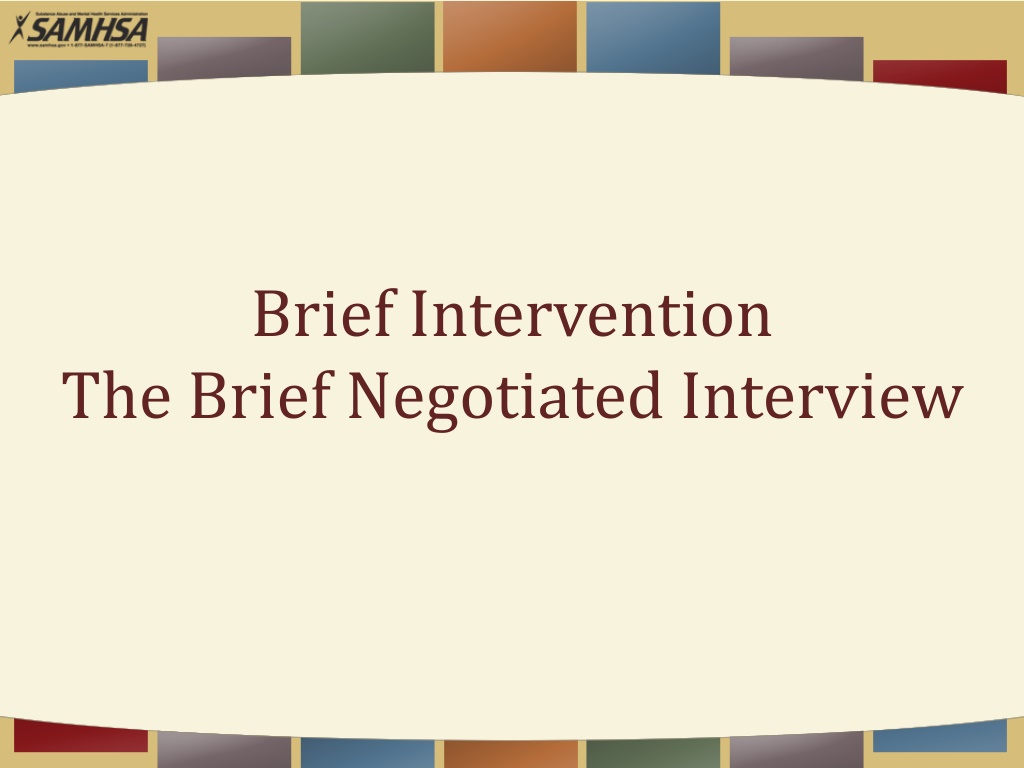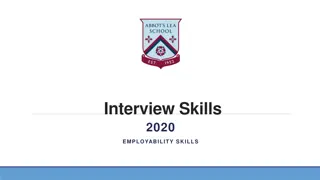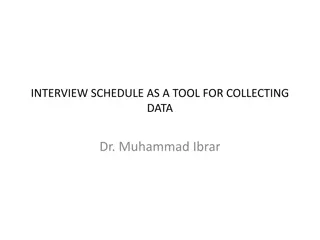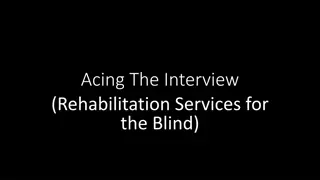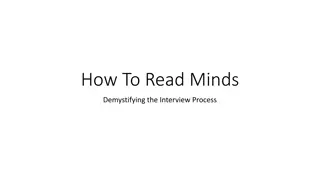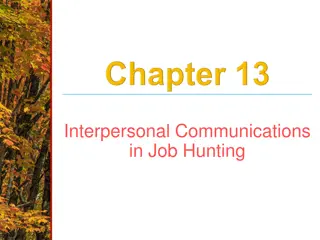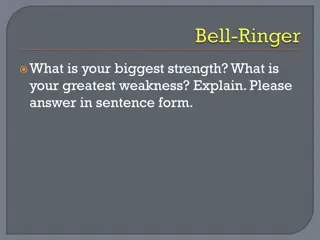The Brief Negotiated Interview
Utilize the "Brief Negotiated Interview" approach for brief interventions. This method involves concise interactions to address issues efficiently. It helps in engaging individuals, discussing concerns, and formulating actionable steps for positive change. The approach involves a structured conversation to navigate the intervention process effectively. Implementing this strategy can lead to impactful outcomes within a limited timeframe, making it ideal for addressing prevalent issues promptly. By utilizing this approach, professionals can tailor interventions to suit individual needs and facilitate meaningful discussions.
Download Presentation

Please find below an Image/Link to download the presentation.
The content on the website is provided AS IS for your information and personal use only. It may not be sold, licensed, or shared on other websites without obtaining consent from the author.If you encounter any issues during the download, it is possible that the publisher has removed the file from their server.
You are allowed to download the files provided on this website for personal or commercial use, subject to the condition that they are used lawfully. All files are the property of their respective owners.
The content on the website is provided AS IS for your information and personal use only. It may not be sold, licensed, or shared on other websites without obtaining consent from the author.
E N D
Presentation Transcript
Brief Intervention The Brief Negotiated Interview
Learning Objectives By the end of this session you will be able to Describe an evidence-based practice model of brief intervention, the brief negotiated interview (BNI). Apply specific motivational interviewing (MI) skills to BNI. Practice SBIRT brief intervention skills using the BNI.
Review of SBIRT Do you recall the primary goal of SBIRT?
Review of SBIRT (continued) Substance use continuum Abstinence Moderate use (lower risk use) At-risk use (higher risk use) Substance Use Disorders (SUDs) Abuse Dependence
Review of SBIRT (continued) Along the substance use continuum, with whom would you negotiate a reduction in use to lower risk levels? Select all that apply. a. Someone with moderate use b.Someone with at-risk use c. Someone who abuses or is dependent
Review of SBIRT (continued) Along the substance use continuum, with whom would you negotiate a treatment referral for full assessment and a level of intervention to be determined? Select all that apply. a. Someone with moderate use b.Someone with at-risk use c. Someone who abuses or is dependent
What Is Brief Intervention? Brief Intervention is a brief motivational and awareness-raising intervention given to risky or problematic substance users.
What Is the Brief Negotiated Interview? There are several models for brief intervention, including the BNI, originally developed by Gail D Onofrio, M.D., Ed Bernstein, M.D., Judith Bernstein, M.S.N., Ph.D., and Steven Rollnick, Ph.D. The BNI is a semistructured interview process based on MI that is a proven evidence-based practice and can be completed in 5 15 minutes. Special acknowledgement is made to Drs. Stephen Rollnick, Gail D Onofrio, and Ed Bernstein for granting permission to orient participants to the brief negotiated interview.
Steps in the BNI 1. Build rapport raise the subject. Explore the pros and cons of use. 2. Provide feedback. 3. Build readiness to change. 4. Negotiate a plan for change.
1. Build RapportRaise the Subject 1. Begin with a general conversation. 2. Ask permission to talk about alcohol or drugs.
1. Build RapportRaise the Subject continued What if the patient does not want to talk about his or her use?
Discuss the Pros and Cons of Use (a) Help me understand through your eyes. 1. What are the good things about using alcohol? 2. What are some of the not- so-good things about using alcohol?
Discuss the Pros and Cons of Use Applying MI (a) Using open-ended questions Enables the patient to convey more information Encourages engagement Opens the door for exploration Using reflections Reflective listening Thinking reflectively
Discuss the Pros and Cons of Use Applying MI (b) Summarizing Reinforces what has been said Shows careful listening
Discuss the Pros and Cons of Use (b) Summarize using a decisional balance
2. Provide Feedback (a) 1. Ask permission to give information. 2. Discuss screening findings. 3. Link substance use behaviors to any known consequences.
2. Provide Feedback (b) Evoke a response: Positive reaction move forward Negative reaction revisit the pros and cons
3. Build Readiness To Change Could we talk for a few minutes about your interest in making a change? On a scale from 1 to 10, 1 being not ready at all and 10 being completely ready, how ready are you to make any changes in your substance use?
4. Negotiate a Plan for Change A plan for reducing use to low-risk levels OR An agreement to follow up with specialty treatment services
BNI With At-Risk Patient View Video Demonstration
BNI Practice Session Roles Patient Interviewer Observer
Closing Reflection Based on your performance in all the practice scenarios, what skills do you think you perform well? Which of your skills needs practice so you can more effectively help your patient?
Whats Next? The closing session in this series will discuss practical aspects of referring patients to treatment.
